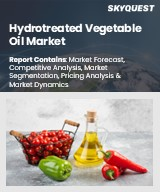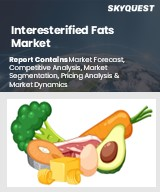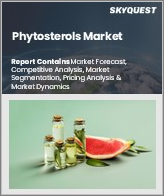
|
시장보고서
상품코드
1661119
세계의 식물성 기름 시장 보고서 : 기름 유형별, 용도별, 지역별(2025-2033년)Vegetable Oil Market Report by Oil Type (Palm Oil, Soybean Oil, Sunflower Oil, Canola Oil, Coconut Oil, Palm Kernel Oil), Application (Food Industry, Biofuels, and Others), and Region 2025-2033 |
||||||
IMARC Group은 2024년 식물성 기름 시장 세계 시장 규모가 2,805억 달러에 달했고, 2025-2033년간 4.81%의 연평균 성장률(CAGR)로 성장하여 2033년에는 4,084억 달러에 달할 것으로 예측했습니다. 건강한 식습관으로의 전환 증가, 식물성 기름의 산업적 사용 증가, 농업 관행의 발전, 가처분 소득 증가, 특정 식용유의 건강상의 이점에 대한 인식 증가는 시장을 이끄는 주요 요인 중 일부입니다.
식물성 기름은 다양한 식물, 주로 씨앗과 열매에서 추출한 액체 지방입니다. 일반적인 공급원으로는 콩, 옥수수, 해바라기, 카놀라유 등이 있습니다. 열전도 매체, 풍미 강화제, 식품에 수분을 첨가하는 성분으로 요리와 베이킹에 널리 사용됩니다. 식물성 기름은 비누, 스킨케어 제품, 바이오연료의 제조에도 이용되고 있습니다. 식물성 기름에는 필수 지방산이 풍부하게 함유되어 있지만, 그 영양가는 원료에 따라 다릅니다. 일부 식물성 기름은 불포화 지방산을 많이 함유하고 있어 적당히 섭취하면 일반적으로 심장에 좋다고 알려져 있습니다.
불포화 지방산을 많이 함유한 건강한 오일에 대한 소비자의 선호도 변화는 전 세계 시장 성장을 가속하는 주요 요인 중 하나입니다. 또한, 소비자들의 건강 지향성이 높아지면서 올리브유와 카놀라유에 대한 수요도 증가하고 있습니다. 화장품, 비누, 바이오연료에 사용되는 식물성 기름의 산업적 용도가 시장 성장에 기여하고 있습니다. 세계 인구 증가와 신흥 경제국의 소득 증가는 식용유에 대한 수요를 촉진하고 있습니다. 농법의 발전은 수확량 증가로 이어져 식물성 기름 생산을 보다 효율적이고 비용 효율적으로 만들고 있습니다. 정부 정책과 무역 규제는 생산 비용과 가격 책정에 영향을 미치며 시장 형성에 중요한 역할을 합니다. 온라인 플랫폼을 포함한 유통 채널은 소비자들이 다양한 석유에 쉽게 접근할 수 있도록 돕고 있습니다. 지속가능성에 대한 관심과 윤리적 농법은 소비자의 선택에 있어 영향력 있는 요소가 되고 있으며, 이는 전 세계 시장에 긍정적인 전망을 가져다주고 있습니다.
식물성 기름 시장 동향/촉진요인:
소비자의 건강지향성 변화
건강을 중시하는 현대 사회에서는 포화지방산이 적고 불포화지방산이 많은 식물성 기름에 대한 수요가 증가하고 있습니다. 팜유나 코코넛유와 같은 포화지방산이 많은 기존 기름보다는 불포화지방산과 다가불포화지방산이 많은 올리브유, 카놀라유, 아보카도유 등이 선호되고 있습니다. 또한, 오메가3 지방산이 풍부한 오일은 그 건강 효과가 입증되면서 선호도가 높아지고 있습니다. 소비자 인식 개선 캠페인, 과학적인 연구, 표시제도가 이러한 추세를 더욱 강화시키고 있습니다. 많은 소비자들이 오일의 건강한 속성에 따라 보다 현명한 선택을 하고 있으며, 이는 건강에 좋다고 판매되는 특정 유형의 식물성 오일에 대한 시장 수요를 크게 촉진하고 있습니다.
산업 응용 분야 증가
식용뿐만 아니라 식물성 기름은 다양한 산업적 용도로 사용되며, 소비자들 사이에서 수요가 크게 증가하고 있습니다. 이 오일은 비누, 세제, 화장품 및 바이오연료 제조의 주요 성분이며, 이는 시장을 더욱 견인하고 있습니다. 식물성 오일의 다기능성은 다양한 산업 공정에서 필수적인 역할을 하고 있습니다. 산업이 확대되고 다양화됨에 따라 식물성 기름에 대한 수요도 증가하고 있습니다. 예를 들어, 바이오연료 분야, 특히 바이오디젤의 부상은 식물성 기름 산업의 성장을 가속하고 있습니다. 또한, 기업들은 식물성 기름의 새로운 산업적 용도를 발견하기 위해 연구에 투자하고 있으며, 이는 수요를 더욱 촉진하고 있습니다.
세계 인구 증가
세계 인구 증가는 당연히 식량 수요를 증가시켜 식용유에 대한 수요를 증가시킬 것입니다. 인구가 증가함에 따라, 특히 소득이 증가하는 신흥국에서는 더 많은 사람들이 더 많은 유형의 기름을 구입할 수 있게 되어 시장 성장에 기여하고 있습니다. 또한 식품 생산용 식물성 기름에 대한 수요도 인구와 함께 증가하고 있습니다. 또한 세계 각국의 요리가 더욱 친숙해지고 인기가 높아짐에 따라 그 요리에 필수적인 오일에 대한 수요도 증가하고 있습니다.
목차
제1장 서문
제2장 조사 범위와 조사 방법
- 조사 목적
- 이해관계자
- 데이터 소스
- 1차 정보
- 2차 정보
- 시장 추정
- 보텀업 접근
- 톱다운 접근
- 조사 방법
제3장 주요 요약
제4장 서론
- 개요
- 주요 업계 동향
제5장 세계의 식물성 기름 산업
- 시장 개요
- 시장 실적
- 수량 동향
- 매출 동향
- COVID-19의 영향
- 시장 분석 : 지역별
- 시장 분석 : 기름 유형별
- 시장 분석 : 용도별
- 시장 예측
- SWOT 분석
- 개요
- 강점
- 약점
- 기회
- 위협
- 밸류체인 분석
- 투입물 공급업체
- 농민
- 컬렉터
- 제조업체
- 유통업체
- 소매업체
- 최종 소비자
- Porter의 Five Forces 분석
- 개요
- 바이어의 교섭력
- 공급 기업의 교섭력
- 경쟁 정도
- 신규 진출업체의 위협
- 대체품의 위협
- 가격 분석
- 주요 가격 지표
- 가격 구조
- 가격 동향
- 시장 성장 촉진요인과 성공 요인
제6장 주요 지역 실적
- 중국
- 시장 동향
- 시장 예측
- 미국
- 시장 동향
- 시장 예측
- 인도
- 시장 동향
- 시장 예측
- 유럽
- 시장 동향
- 시장 예측
- 인도네시아
- 시장 동향
- 시장 예측
- 말레이시아
- 시장 동향
- 시장 예측
- 브라질
- 시장 동향
- 시장 예측
- 기타
- 시장 동향
- 시장 예측
제7장 시장 : 기름 유형별
- 팜유
- 시장 동향
- 시장 예측
- 대두유
- 시장 동향
- 시장 예측
- 해바라기유
- 시장 동향
- 시장 예측
- 카놀라유
- 시장 동향
- 시장 예측
- 코코넛유
- 시장 동향
- 시장 예측
- 팜핵유
- 시장 동향
- 시장 예측
제8장 시장 : 용도별
- 식품 산업
- 시장 동향
- 시장 예측
- 바이오연료
- 시장 동향
- 시장 예측
- 기타
- 시장 동향
- 시장 예측
제9장 경쟁 구도
- 시장 구조
- 주요 기업
제10장 식물성 기름 제조
- 제품 개요
- 팜유
- 카놀라유
- 코코넛유
- 대두유
- 세부 프로세스 플로우
- 팜유
- 카놀라유
- 코코넛유
- 대두유
- 다양한 유형의 단위 작업
- 팜유
- 카놀라유
- 코코넛유
- 대두유
- 물질 수지와 원재료 요건
- 팜유
- 카놀라유
- 코코넛유
- 대두유
제11장 프로젝트 상세, 필요조건 및 비용
- 토지 요건과 비용
- 건설 요건과 비용
- 공장 레이아웃
- 공장 기계
- 기계 사진
- 원재료 요건과 지출
- 원재료와 최종 제품 사진
- 포장 요건과 지출
- 운송 요건과 지출
- 유틸리티 요건과 지출
- 인원 요건과 지출
- 기타 설비 투자
제12장 융자와 자금 원조
제13장 프로젝트의 경제성
- 프로젝트의 자본비용
- 기술 경제적 파라미터
- 공급망 단계별 제품 가격과 마진
- 과세 및 감가상각
- 수입 예측
- 지출 예측
- 재무 분석
- 이익 분석
제14장 주요 기업 개요
- Archer-Daniels-Midland Company
- Bunge Limited
- Cargill, Incorporated
- Louis Dreyfus Company BV
- Wilmar International Ltd.
The global vegetable oil market size reached USD 280.5 Billion in 2024. Looking forward, IMARC Group expects the market to reach USD 408.4 Billion by 2033, exhibiting a growth rate (CAGR) of 4.81% during 2025-2033. The rising shift towards healthier eating habits, increasing industrial uses of vegetable oils, advances in agricultural practices, rising disposable income, and increased awareness about the health benefits of certain cooking oils are some of the major factors propelling the market.
Vegetable oil is a liquid fat extracted from various plants, primarily from seeds or fruits. Common sources include soybean, corn, sunflower, and canola. It is widely used in cooking and baking as a heat transfer medium, flavor enhancer, and ingredient that adds moisture to food. Vegetable oils are also utilized in the production of soaps, skincare products, and biofuels. They are rich in essential fatty acids, though the nutritional value can vary depending on the source. Some vegetable oils are high in unsaturated fats, which are generally considered heart-healthy when consumed in moderation.
Changing consumer preference for healthier oils that are rich in unsaturated fats represents one of the key factors driving the growth of the market across the globe. The market is also driven by the rising health consciousness among consumers which is further influencing the demand for oils like olive and canola. Industrial applications of vegetable oils in cosmetics, soaps, and biofuels are contributing to the market growth. The growing global population and rising incomes in emerging economies are fueling the need for edible oils. Advances in agricultural practices are leading to improved yields, thus making vegetable oil production more efficient and cost-effective. Government policies and trade regulations play a crucial role in shaping the market, affecting production costs and pricing. Distribution channels, including online platforms, facilitate easier consumer access to a variety of oils. Sustainability concerns and ethical farming practices are becoming influential factors in consumer choice which is creating a positive outlook for the market across the globe.
Vegetable Oil Market Trends/Drivers:
Changing consumer preferences for healthier options
In the contemporary health-conscious society, there is a growing demand for vegetable oils that are low in saturated fats and high in unsaturated fats. Oils, such as olive, canola, and avocado oils, rich in monounsaturated and polyunsaturated fats, are increasingly preferred over traditional oils high in saturated fats like palm or coconut oil. Additionally, oils rich in omega-3 fatty acids are finding favor for their proven health benefits. Public awareness campaigns, scientific research, and labeling initiatives are amplifying this trend. Many consumers are making more informed choices based on the health attributes of oils, which is significantly driving market demand for specific types of vegetable oils that are marketed as being healthier.
Rising industrial applications
Beyond the culinary realm, vegetable oils have numerous industrial uses that are considerably widening their demand among consumers. These oils are key ingredients in the production of soaps, detergents, cosmetics, and even biofuels which is further driving the market. The multi-functionality of vegetable oils makes them indispensable in a variety of industrial processes. As industries expand and diversify, so does the demand for vegetable oils. For instance, the rising biofuels sector, particularly biodiesel, is also facilitating the growth of the vegetable oil industry. Companies are also investing in research to discover new industrial applications for vegetable oils, which is further driving its demand.
Rising worldwide population
The world's growing population naturally increases the demand for food and, by extension, cooking oils which is acting as a major growth-inducing factor in the market. As the population rises, especially in emerging economies where incomes are also increasing, more people can afford a wider variety of oils which is contributing to the market growth. The demand for vegetable oils for food production also grows in tandem with the population. Moreover, as global cuisines become more accessible and popular, the oils integral to those cuisines see a rise in demand.
Vegetable Oil Industry Segmentation:
Breakup by Oil Type:
- Palm Oil
- Soybean Oil
- Sunflower Oil
- Canola Oil
- Coconut Oil
- Palm Kernel Oil
Palm oil accounts for the largest market share
The demand for palm oil in the vegetable oil market is driven by a variety of factors. Primarily, its cost-effectiveness makes it an attractive option for both consumers and industries. Palm oil is one of the most yield-efficient oil crops, which is leading to lower production costs and, consequently, more affordable retail prices. In addition to this, the versatility of palm oil makes it highly desirable across multiple sectors. In the food industry, it is used extensively for frying, baking, and as an ingredient in processed foods like snacks and confectionery items. It also serves as a key ingredient in non-food items, such as cosmetics, detergents, and biofuels, broadening its demand in the market. In line with this, the ease of storage and long shelf life of palm oil adds to its appeal. Unlike some other vegetable oils, palm oil is stable at room temperature, which reduces the need for refrigeration and makes it suitable for tropical climates.
Breakup by Application:
- Food Industry
- Biofuels
- Others
Food industry dominates the market
In the food industry, vegetable oils serve multiple functions that extend beyond mere cooking. They are widely used as frying mediums due to their high smoke points, thus making them ideal for deep-frying items like fries, doughnuts, and various fast foods. Their heat-stable nature makes them a suitable choice for sauteing and pan-frying as well. Vegetable oils are also employed as an ingredient in baked goods, such as bread, cakes, and cookies to add moisture, improve texture, and extend shelf life. Moreover, they act as emulsifiers and stabilizers in processed foods, aiding in the blending of ingredients and preventing separation in products like mayonnaise, dressings, and spreads. Certain types of vegetable oils, like olive oil, are often used as a flavor enhancer in culinary applications, bringing their distinct taste to dishes. In addition, they serve as a base in the production of margarine and vegetable shortening, offering a plant-based alternative to animal fats.
Breakup by Region:
- China
- United States
- India
- Europe
- Indonesia
- Malaysia
- Brazil
- Others
China holds the largest market share
The report has also provided a comprehensive analysis of all the major regional markets, which include China, the United States, India, Europe, Indonesia, Malaysia, Brazil, and others. According to the report, China accounted for the largest market share.
In China, the vegetable oil market is experiencing substantial growth due to several driving factors. Primarily, rapid urbanization and increasing household incomes are leading to a rise in demand for better-quality and diverse food products, including vegetable oils. As lifestyles become more hectic, the reliance on easy-to-cook food, which often requires cooking oils, is also rising. Health consciousness among consumers in the country is growing, which is pushing the demand for healthier vegetable oil options, such as olive and canola oils that are rich in unsaturated fats. The Chinese government's health initiatives and guidelines advocating lower consumption of saturated fats further endorse this trend. Industrial use of vegetable oils in China is burgeoning. With a booming manufacturing sector, the demand for vegetable oils in industrial applications, including biofuels, cosmetics, and even in the pharmaceutical industry, is increasing.
Competitive Landscape:
In the vegetable oil market, key players are engaging in a range of strategic activities to maintain a competitive edge. One of the primary focuses is on product diversification. Companies are introducing a variety of oils derived from different plants to cater to the health-conscious consumer, including options like avocado, grapeseed, and flaxseed oils. Research and development (R&D) are another area of significant investment. Companies are researching new refining techniques, long-lasting shelf-life solutions, and alternative industrial applications for vegetable oils. This not only expands market demand but also allows for innovation within the sector. Sustainability is increasingly becoming a cornerstone of business strategies. Many companies are adopting sustainable farming practices, reducing carbon footprints, and committing to fair trade practices to appeal to environmentally conscious consumers. Market penetration and geographical expansion are also on the agenda. Companies are entering new markets, particularly in developing nations, and enhancing their distribution networks both offline and online to reach a wider audience.
The report has provided a comprehensive analysis of the competitive landscape in the market. Detailed profiles of all major companies have also been provided. Some of the key players in the market include:
- Archer-Daniels-Midland Company
- Bunge Limited
- Cargill, Incorporated
- Louis Dreyfus Company BV
- Wilmar International Ltd
Key Questions Answered in This Report
- 1.What is the impact of COVID-19 on the global vegetable oil market?
- 2.What will be the global vegetable oil market outlook during the forecast period 2025-2033?
- 3.What was the global vegetable oil market size in 2024?
- 4.What are the major global vegetable oil market drivers?
- 5.What are the major global vegetable oil market trends?
- 6.What is the global vegetable oil market breakup by oil type?
- 7.What is the global vegetable oil market breakup by application?
- 8.What are the major regional markets in the global vegetable oil industry?
- 9.Who are the leading global vegetable oil industry players?
Table of Contents
1 Preface
2 Scope and Methodology
- 2.1 Objectives of the Study
- 2.2 Stakeholders
- 2.3 Data Sources
- 2.3.1 Primary Sources
- 2.3.2 Secondary Sources
- 2.4 Market Estimation
- 2.4.1 Bottom-Up Approach
- 2.4.2 Top-Down Approach
- 2.5 Forecasting Methodology
3 Executive Summary
4 Introduction
- 4.1 Overview
- 4.2 Key Industry Trends
5 Global Vegetable Oil Industry
- 5.1 Market Overview
- 5.2 Market Performance
- 5.2.1 Volume Trends
- 5.2.2 Value Trends
- 5.3 Impact of COVID-19
- 5.4 Market Breakup by Region
- 5.5 Market Breakup by Oil Type
- 5.6 Market Breakup by Application
- 5.7 Market Forecast
- 5.8 SWOT Analysis
- 5.8.1 Overview
- 5.8.2 Strengths
- 5.8.3 Weaknesses
- 5.8.4 Opportunities
- 5.8.5 Threats
- 5.9 Value Chain Analysis
- 5.9.1 Input Suppliers
- 5.9.2 Farmers
- 5.9.3 Collectors
- 5.9.4 Manufacturers
- 5.9.5 Distributors
- 5.9.6 Retailers
- 5.9.7 End-Consumers
- 5.10 Porter's Five Forces Analysis
- 5.10.1 Overview
- 5.10.2 Bargaining Power of Buyers
- 5.10.3 Bargaining Power of Suppliers
- 5.10.4 Degree of Competition
- 5.10.5 Threat of New Entrants
- 5.10.6 Threat of Substitutes
- 5.11 Price Analysis
- 5.11.1 Key Price Indicators
- 5.11.2 Price Structure
- 5.11.3 Price Trends
- 5.12 Key Market Drivers and Success Factors
6 Performance of Key Regions
- 6.1 China
- 6.1.1 Market Trends
- 6.1.2 Market Forecast
- 6.2 United States
- 6.2.1 Market Trends
- 6.2.2 Market Forecast
- 6.3 India
- 6.3.1 Market Trends
- 6.3.2 Market Forecast
- 6.4 Europe
- 6.4.1 Market Trends
- 6.4.2 Market Forecast
- 6.5 Indonesia
- 6.5.1 Market Trends
- 6.5.2 Market Forecast
- 6.6 Malaysia
- 6.6.1 Market Trends
- 6.6.2 Market Forecast
- 6.7 Brazil
- 6.7.1 Market Trends
- 6.7.2 Market Forecast
- 6.8 Others
- 6.8.1 Market Trends
- 6.8.2 Market Forecast
7 Market by Oil Type
- 7.1 Palm Oil
- 7.1.1 Market Trends
- 7.1.2 Market Forecast
- 7.2 Soybean Oil
- 7.2.1 Market Trends
- 7.2.2 Market Forecast
- 7.3 Sunflower Oil
- 7.3.1 Market Trends
- 7.3.2 Market Forecast
- 7.4 Canola Oil
- 7.4.1 Market Trends
- 7.4.2 Market Forecast
- 7.5 Coconut Oil
- 7.5.1 Market Trends
- 7.5.2 Market Forecast
- 7.6 Palm Kernel Oil
- 7.6.1 Market Trends
- 7.6.2 Market Forecast
8 Market by Application
- 8.1 Food Industry
- 8.1.1 Market Trends
- 8.1.2 Market Forecast
- 8.2 Biofuels
- 8.2.1 Market Trends
- 8.2.2 Market Forecast
- 8.3 Others
- 8.3.1 Market Trends
- 8.3.2 Market Forecast
9 Competitive Landscape
- 9.1 Market Structure
- 9.2 Key Players
10 Vegetable Oil Manufacturing
- 10.1 Product Overview
- 10.1.1 Palm Oil
- 10.1.2 Canola Oil
- 10.1.3 Coconut Oil
- 10.1.4 Soybean Oil
- 10.2 Detailed Process Flow
- 10.2.1 Palm Oil
- 10.2.2 Canola Oil
- 10.2.3 Coconut Oil
- 10.2.4 Soybean Oil
- 10.3 Various Types of Unit Operations Involved
- 10.3.1 Palm Oil
- 10.3.2 Canola Oil
- 10.3.3 Coconut Oil
- 10.3.4 Soybean Oil
- 10.4 Mass Balance and Raw Material Requirements
- 10.4.1 Palm Oil
- 10.4.2 Canola Oil
- 10.4.3 Coconut Oil
- 10.4.4 Soybean Oil
11 Project Details, Requirements and Costs Involved
- 11.1 Land Requirements and Expenditures
- 11.2 Construction Requirements and Expenditures
- 11.3 Plant Layout
- 11.4 Plant Machinery
- 11.5 Machinery Pictures
- 11.6 Raw Material Requirements and Expenditures
- 11.7 Raw Material and Final Product Pictures
- 11.8 Packaging Requirements and Expenditures
- 11.9 Transportation Requirements and Expenditures
- 11.10 Utility Requirements and Expenditures
- 11.11 Manpower Requirements and Expenditures
- 11.12 Other Capital Investments
12 Loans and Financial Assistance
13 Project Economics
- 13.1 Capital Cost of the Project
- 13.2 Techno-Economic Parameters
- 13.3 Product Pricing and Margins Across Various Levels of the Supply Chain
- 13.4 Taxation and Depreciation
- 13.5 Income Projections
- 13.6 Expenditure Projections
- 13.7 Financial Analysis
- 13.8 Profit Analysis
14 Key Player Profiles
- 14.1 Archer-Daniels-Midland Company
- 14.2 Bunge Limited
- 14.3 Cargill, Incorporated
- 14.4 Louis Dreyfus Company BV
- 14.5 Wilmar International Ltd.

















